Posts
-
Let's Read the 4e Monster Manual 2: Tiger
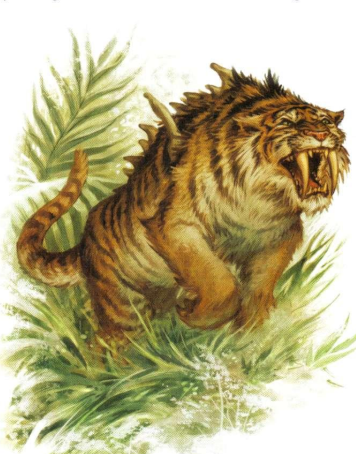
Copyright 2009 Wizards of the Coast. This post is part of a series! Click here to see the rest.
Tigers are real animals and have been part of the game since its beginnings. They’re some of the only animals whose “mundane” version was considered worthy of a monster stat block at this point in the edition.
The Lore
The book describes tigers as powerful and cunning predators that can be found in “rugged natural environments”. Let’s elaborate on that a bit, shall we?
According to Wikipedia “rugged natural environments” means mostly flat or hilly forests, but those can range from cold Siberian taigas to temperate forests to tropical jungles. A tiger requires a large amount of territory, which allows it to range far and hunt its prey (usually large herbivores). Tigers are “solitary but social”: they hunt alone but might nest together, with their range areas overlapping.
The Monster Manual 2 does add a bit of interesting fantastic lore by saying tigers are sometimes domesticated by ogres of all people to serve as guard and hunting animals.
A wild D&D tiger is not shy about including adventurers in its menu. If they run across a battle while hunting, they might stalk its edges and pounce on any combatant that gets separated from the rest.
Dire tigers are as usual larger, stronger and spikier. They’re bolder and less opportunistic, directly stalking prey that seems to be alone and weaker than them. Their behavior is a lot closer to that of the tiger in The Jungle Book than that of a real-world animal.
The Numbers
Both mundane and dire tigers are Large Natural Beasts with low-light vision, a ground speed of 8, and a climb speed of 4. Their signature ability is Feral Surge, an encounter power that allows them to take a move action as a minor action.
Tiger
“Mundane” tigers are Level 6 Skirmishers with 73 HP. Their basic attack is a bite that does immediate and ongoing damage.
During a fight, the tiger always wants to be moving and charging, as being on the move makes it much more dangerous. If forced to choose between a static fight and running away, it will likely take the second option every time.
The traits that make it want to move are Blur of Fur, which gives it +4 AC against opportunity attacks in any turn where it moves 2 or more squares; and Charging Pounce, which gives it bonus damage on charge attacks and makes it so charging doesn’t end its turn. So it could use its standard action to charge, and then either a move action or Feral Surge to move away immediately.
Dire Tiger
Dire Tigers are Level 8 Soldiers with 89 HP. Their bites are stronger, and they’re much more likely to accept the challenge of a stand-up fight. Even then they’ll try to single out the weakest available target and kill it first.
Hunter’s Instinct is an ability that helps then with that. It works exactly like the Hunter’s Quarry ability of a PC ranger. The tiger spends a minor action to make the nearest enemy its quarry, which lasts until the end of the encounter or until it uses this ability again. The quarry takes extra damage from all of the tiger’s attacks.
The dire tiger can also use a Leaping Pounce as a reaction whenever its quarry is within 5 squares. It allows the creature to shift to a space adjacent to the quarry and bite it. Since this is a leap, the tiger can cross enemy spaces during the shift.
Marking the right quarry requires some clever positioning, but once that happens it will be hard for the other players to protect the victim from the tiger’s leaps.
Sample Encounters and Final Impressions
These tigers have some cool mechanics to them, which is better than the generic bags of HP I remember them being in previous editions. They also feel pretty different from each other! I still would hesitate a bit before placing wild tigers as opposition to my PCs, what with them being endangered in reality and all.
We have two sample encounters here:
-
Level 7: A couple of ogre savages taking their two pet tigers and their pet macetail behemoth out for a stroll. Shrek and Fiona?
-
A weretiger running with a pack/harem of three dire tigers. The fact that you have tigers running in packs should be a hint that there’s something unnatural going on.
-
-
Let's Read the 4e Monster Manual 2: Steel Predator
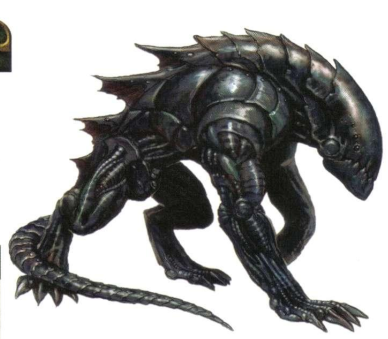
Copyright 2009 Wizards of the Coast. This post is part of a series! Click here to see the rest.
I think I first saw this monster in one of the “late” Monster Manuals for 3.x, which makes it fairly recent.
The Lore
Designed by Bane himself (“Original Design: Do Not Steal”), these living constructs are designed as long-ranging assassination engines. They seem to be his take on the “Retriever” concept pioneered by the primordials, with the main difference being that the god of war is not interested in taking prisoners.
Steel Predators are a little weaker individually, but unlike the retrievers they’re still in production. They can travel the planes in search of their target, though their means of travel is not quick enough to be a combat ability. These things just love eating magic items: the more loaded the victim, the more vigorous the pursuit. Once a steel predator kills its target it will usually devour them, items and all. They also have a bit of golem-like magical resistance that means they get stronger when they take thunder or lightning damage.
As a side effect of this refined palate, steel predator bodies are rich in residuum, which can ironically make them a target for powerful, brave or foolhardy hunters looking for a big score. When not on a mission, most steel predators hang out in Bane’s native plane of Chernoggar, patrolling it alongside platoons of bladelings.
The Numbers
Steel Predators are Large Immortal Animates with the Living Construct keyword. They’re Level 20 Elite Soldiers with 388 HP, darkvision, and a ground speed of 8. As mentioned above, they can cross planar boundaries but this ability doesn’t make it into their combat stat block. They have a +2 bonus to saves against ongoing damage (for a total of +4 when combined with their elite save bonus).
These creatures have the body structure of a big cat, and they fight accordingly, pouncing and biting with their metal jaws. Their basic bite attack marks for a turn on a hit. They can also make a Vicious Pounce that works as a charge against Fortitude, does the same damage as a bite, and knocks prone. Their multiattack ability is a bit weaker than a standard double attack, but it’s still flavorful: Snap Jaw allows the steel predator to make a bite attack. If that hits it also knocks the target prone, and the creature can make another bite attack against a different target.
Their most overtly supernatural attack is a Resonating Roar, a Close Burst 3 attack that deals heavy thunder damage, dazes, and deafens (save ends both). This is a “recharge 5+” attack, but it also recharges automatically when the predator takes thunder or lightning damage.
Finally, when an adjacent creature shifts, they can use Shifting Steel as a reaction to shift into the vacated square.
Tactics are fairly simple: pounce, roar, then keep biting with Snap Jaw until the roar recharges. This should keep the PCs quite busy while the other monsters attack them.
Sample Encounters and Final Impressions
These things look enough like xenomorphs from Aliens that I’m surprised they don’t have acid blood. Maybe that would be too on the nose.
As mentioned above, Bane often sends steel predators on remote missions. They end up working alongisde other servants of the god, or with other creatures that share the same immediate goals. In that latter case, they’re known for turning on their allies of convenience if those allies behave in a way that displeases Bane.
The example encounter is Level 21, and has 2 steel predators accompanying 2 marut castigators. The maruts are likely mercenaries hired by an agent of Bane.
-
Let's Read the 4e Monster Manual 2: Star Spawn
This post is part of a series! Click here to see the rest.
Though the Warlock class was introduced late in D&D 3.x, it was Fourth Edition that really made it shine. In addition to the infernal warlocks of the previous edition, the Player’s Handbook also gave us fey and star pact warlocks. Different pacts provided different mechanical and lore flavor, and made the class approachable to people who didn’t want to play someone who had literally sold their soul to the devil.
Fey warlocks were an immediate hit because they tied to the lore of the Feywild, which was awesome from the start. You get your powers from David Bowie’s Goblin King, what’s not to love about that?
While I personally loved star warlocks, their lore required a certain previous familiarity with “cthulhoid” narratives that was by no means universal among D&D players. I mean, in this one-shot I GMed shortly after acquiring the books I had a player who honestly believed they were supposed to be New Agey astrologers1.
The reason I’m talking about PC warlocks in a Monster Manual reading is that those paragraphs provide the context you need to understand why the Wish Upon a Star article from Dragon #366 was such a big deal. While it was mostly focused on adding more options for star warlocks, it also included the first concrete bit of lore on the “pact entities” for star warlocks. More information about them would be added in subsequent books, and in the Monster Manual 2 they get an entry for monsters themed after them.
The Lore
Most people in 4e’s implied setting don’t think too hard about the stars in the night sky. To many they’re just pretty lights. Amateur astronomers can point out constellations and identify a few specific stars by name.
True scholars of the stars know about the other constellations. They know that some of those stars have fallen under the influence of certain powerful entities, who use them to gaze at the world from across the infinite void. Their gazes might be filled with fury, with hunger, or with emotions unfathomable to feeble mortal minds. When you speak their true names, they listen, and might even answer. Opinions differ as to whether that is a good or a bad thing.
These stellar entities are usually associated with the Far Realm. Traditional lore about the Far Realm says it’s a separate plane of existence, so according to that it could be that these entities are using their stars as windows to our plane. But this also raises an alternate, scarier possibility: maybe the “Far Realm” isn’t a separate plane at all. Maybe it’s just what you find if you travel far enough into the void.
Not every star is the avatar of an eldritch alien being, though some star warlocks have recurring nightmares where every star in the sky opens up to reveal an eye staring at them.
Most of the information on the known eldritch stars comes from a scroll known as The Revelations of Melech, which is the sort of rare sanity-blasting tome that should be very familiar to Call of Cthulhu players. It has the same in-world status the Demonomicon of Iggwilv (which lists demons) or the Codex of Betrayal (devils).
And now we get into the lore contained in the MM2. The most learned students of the sky know of an orange star named Allabar, The Opener of the Way. Allabar only appears when the world is about to enter a time of great turmoil, be it a great war, a mighty ritual, or something similar. It races across the sky in a seemingly random trajectory that passes by one or more of the other “special” stars. When this happens, the way is opened for that star to release a Star Spawn into the world.
Star Spawn are the anthropomorphic personifications of a specific star’s will. Once they enter the world, they seek to enact that will. Some stay for only as long as the conjunction with Allabar lasts, other can remain indefinitely or until defeated. Some are solitary, others gather cults and minions around themselves. Regardless of their specific MOs, star spawn tend to be pretty evil from a mortal’s point of view.
No one knows for sure how or why this whole process happens. Is Allabar a natural phenomenon of the void, or a sapient being with designs of its own? Is there a rhyme or reason to its wanderings? The warlock Thulzar claimed to have charted every star spawn incursion since the fall of Bael Turath and found a pattern, but he vanished along with his tower and all his notes after a starless night, leaving only a glassy crater behind.
The Monster Manual 2 contains three Star Spawn in this entry, and we’ll look a bit more into their specific lore and the lore of their star in their sections.
The Numbers
Star Spawn are Aberrant Humanoids. The first one in this entry is Medium, all others are Large. All of them have Darkvision, a ground speed of 6, and communicate using telepathy with a range of 10 squares. Everything else about them varies per stat block.
Herald of Hadar
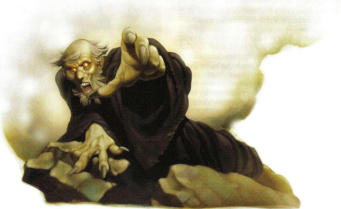
Copyright 2009 Wizards of the Coast. Morinbund Hadar used to be the brightest star in the sky. During the tribulations that led to the fall of Bael Turath, it flared up into a burning brand visible even during the day. Afterwards, it faded to a barely visible red ember. Hadar’s dying gasps send its heralds into the world so they can harvest life energy and delay its inevitable end.
The only Medium star spawn in this entry, heralds of Hadar look almost human save for their glowing eyes and hostility to all forms of life, which they attempt to drain. They’re Level 15 Brutes with 180 HP.
Heralds use their Hungry Claws to fight, and they can make two basic attacks with a single action. Once per encounter they can step it up and use Feeding Frenzy to make up to three attacks (though no more than two on the same target). Their life-force drain is the Breath of a Dying Star, a Close Blast 5 encounter power that targets Reflex, does good damage, and prevents targets from regaining HP and spending healing surges (save ends). I imagine the claw attacks drain life as well, but that’s probably just represented as part of their damage.
Whenever someone spends a healing surge within 5 squares of the herald, Hadar’s Hunger allows it to react in a variety of ways. Choose one whenever this triggers: shift 3 squares closer to the triggering creature; make a basic attack; regain the use of an encounter power; gain +2 to attacks for a turn.
It looks like the Herald will want to focus most of its attacks on a single PC, but will use the Breath on the others. That way it will leave someone still able to spend healing surges so it can recharge its powers. Despite their “berserk” fighting style, heralds are still sapient and capable of making alliances of convenience with other creatures.
Maw of Acamar

Copyright 2009 Wizards of the Coast. If Hadar is dying, Acamar is already dead. This corpse-star is a black void that devours everything that passes by it, even other stars and their light. Its hunger is endless and without a purpose other than consumption itself. The Maws of Acamar are avatars of that hunger, living gateways through which the dead star can extend its ruinous grasp to the world. Unlike the other Spawn, they come to the world under their own power, for even The Opener of the Way avoids passing too close to Acamar.
Maws are Level 15 Controllers with 145 HP. Where Heralds of Hadar fight with berserk intensity, Maws of Acamar just kinda stroll around the battlefield and let the constant effects of their presence do the work for them.
The gravitational field of their black hole progenitor is expressed as an aura (5) named Hungry Star. Anyone inside who wishes to move away from the Maw must pay 3 movement points per square instead of the usual 1. Even if they do it’s futile because the Maw can use Corpse Star’s Grip (Close Burst 5 vs. Fortitude; minor action) to pull them 3 squares.
The destructive part of that gravitational pull is expressed as 2 different attacks, both of which inflict ongoing damage instead of instant wounds. Devouring Star is a Close Burst 3 attack targetting Fortitude that inflicts 10 ongoing damage; Devouring Touch is a focused Reach 2 version that inflicts 15 ongoing damage on a single target. In both cases the Destroyer of Life passive trait prevents adjacent enemies from shedding all of that damage with a single save. The save only reduces the total damage by 5.
Yes, it’s possible to meet multiple Maws at once. They love to surround foes and tear them apart by pulling them in several directions at once. I’d probably make them immune to each other’s attacks, but that’s wouldn’t be the case for any other ally. Anything and anyone who stands too close to a Maw is going to be sucked in. If you pair them with other monsters, they would do well to stay away from their “buddy”.
Scion of Gibbeth
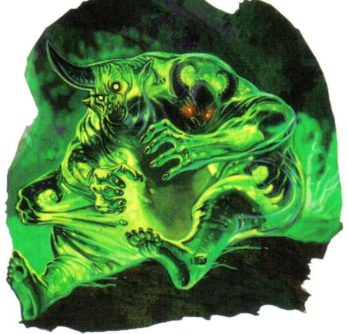
Copyright 2009 Wizards of the Coast. Gibbeth is a cursed green sun which gestates at its core an unknowable being. Warlocks and the like say that this being will only show its true face at the end of the world, and this will send the tattered remains of the universe into inescapable madness.
Scions of Gibbeth are shards of this green star, providing a little taste of what is to come. No two people who see one can agree on its appearance, save to say it is horrible. Perhaps its true form is literally incomprehensible to mortal minds, and the varied appearances described are a result of the people in question instinctively trying to cope with this.
These abominations wander the world pursuing their enigmatic goals. They tend to attack any living creature that draws too close, but they tolerate the presence of worshippers and cultists.
Scions are Level 17 Controllers with 163 HP. Their abilities work at range and are designed to keep PCs away. They’re surrounded by an Aura of Revulsion with size 10, enough to cover most of the battlefield. Creatures inside can’t target the Scion with melee or ranged attacks unless it’s the enemy nearest to them.
Its basic attack are vanilla Slams, but the others make up for it. Mind-Splintering Gaze (range 20) deals light psychic damage and dominates (save ends); Gibbeth’s Baleful Glare does the same damage and slides the target 2 squares.
That sets up the Scion’s basic tactics: stay well away from the PCs and dominate them, gently nudging them away when they attempt to close. If they do manage to close, there’s a couple more tricks available to the creature. Offering to Gibbeth gives it a +2 attack bonus for a turn whenever a PC spends a healing surge within 2 squares of it; and Revelation of Gibbeth is a burst 5 that triggers when the Scion dies. This glimpse of its true form acts as an attack against Will. Affected targets are Dazed, and must spend their sole action charging or making a basic attack against their nearest ally. This is a save ends condition, so even if the dead Scion was the last monster on the board, the party might still need to contend with the effect for a few rounds until everyone makes their save.
Sample Encounters and Final Impressions
I love all of this star lore! It feels so new, you know? It’s “cthulhoid” without actually involving the Cthulhu Mythos and this is a big entry about aberrant monsters that doesn’t contain a single tentacle anywhere in it. It’s also scarier in places than even the traditional fiend lore. “There’s a place in a different plane that’s full of evil fire” doesn’t quite have the same visceral kick as “each star opens to reveal an eye and they’re all looking at you”.
I even think it’s cool that Hadar’s and Acamar’s basic descriptions are the result of taking a real astronomical entity and running it through a Lovecraft and/or Death Metal translator filter. A red supergiant is “ancient and dying, gasping for breath as it tries to prolong its doomed existence”. A black hole is a Corpse Star!
I don’t think they ever officially added Atropus from Elder Evils to the star “pantheon”, but he’s a perfect fit. “The World Born Dead orbits The Corpse Star!”, cries the mad warlock as invisible star spawn tear him limb from limb in broad daylight.
The only place where I think this entry stumbles a bit is the sample encounters. The lore of the star spawn is cool but it makes them stand a bit apart from the more traditional D&D monsters, so it feels strange to see them paired with those same monsters. You might need to reskin some of those monsters to make them more star-aspected.
We have two encounters:
-
Level 13: A Herald of Hadar teams up with a Beholder Eye of Flame and 2 Battle Wight Commanders. A classic front-line and artillery formation.
-
Level 13: A Maw of Acamar is accompanied by 2 hook horrors and 2 mind flayer infiltrators. Here you want the others to form a perimeter around the Maw and try to keep the PCs boxed in.
-
There were also mechanical reasons for why they didn’t become as popular, but these have been more extensively discussed elsewhere and don’t quite fit a monster-focused post. ↩
-
-
Let's Read the 4e Monster Manual 2: Sprite Swarm
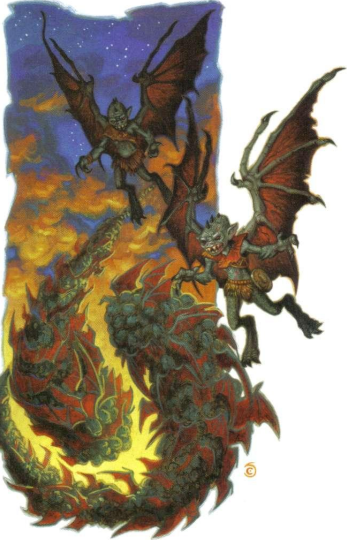
Copyright 2009 Wizards of the Coast. This article is part of a series! Click here to see the rest.
Sprites are super-tiny humanoid fey, tinier even than the pixies that would show up as a playable option in Heroes of the Feywild. I think they’ve been in the game since at least AD&D 1st Edition in some for or another.
The Lore
Sprites in earlier editions tended to be described as just tiny fairy folk who liked all the usual Victorian Fairy things like song and dance and pastoral nature. They might have a propensity for pranks, but normally didn’t get more aggressive than that unless the PCs were out to exterminate them. A single sprite was pretty much harmless, but they often came in large numbers.
These aren’t the sprites from earlier editions. These are Umbral Sprites.
Umbral Sprites are just as tiny as the nice variety, but they’re cruel, violent, and territorial. Interactions between them and the PCs skip right past the talky and pranky stages and go right to combat as swarms of these things descend upon them. A single umbral sprite is still harmless to an adventurer, but a swarm of them is dangerous enough to get monster stats.
Though these tiny terrors are native to the Feywild, they tend to seek out areas that contain crossings to the Shadowfell to claim as territory. Spriggans and ill-intentioned gnomes tend to ally with them and use them as diversions for subtler schemes. It’s hard to notice gnomes sneaking into your vaults when you have a cloud of angry sprites poking out your eyes.
The Numbers
This entry gives us stats for a fairly small swarm of umbral sprites. This is a Medium swarm composed of Fey Humanoids, and counts as a Level 4 Controller with 55 HP. It has blindsight with range 6, a ground speed of 4, and a flight speed of 6 with Hover.
It also has the standard swarm traits: it takes half damage from single-target attacks, and extra damage from area attacks. Its Swarm Attack aura (1) deals 3 damage to creatures caught inside.
Its basic attack is a Swarm of Fangs and Blades, but aside from the name it’s nothing spectacular. Their special Darkwave attack (recharge 5+) is more impressive. It’s a Close Burst 3 that targets Reflex, does necrotic damage, and creates a zone of darkness that lasts for a durn.
They also have the gnome’s Fade Away power, becoming invisible as a reaction to taking damage once per encounter. This invisibility lasts for a turn, or until they hit or miss with an attack.
When fighting a group of PCs, they’re going to rely on Darkwave to keep them in the dark and will use basic attacks and the swarm aura to deal damage while that power recharges. The sprites are unaffected by their own darkness due to their blindsight.
Sample Encounters and Final Impressions.
You can model a larger group of umbral sprites by using several swarms in an encounter, or by increasing the level and size of a single one. They also make me think about adapting The Dreams of Ruin to 4e, because they look like they are the base creature for Murdersprites. A murdersprite swarm is probably more like a Colossal Level 14-18 Brute, though.
The sample encounter is Level 5, and is a grab-bag of Feywild hazards: 2 ettercap fang guards working with 2 sprite swarms and 2 fey panthers.
-
Let's Read the 4e Monster Manual 2: Spriggan
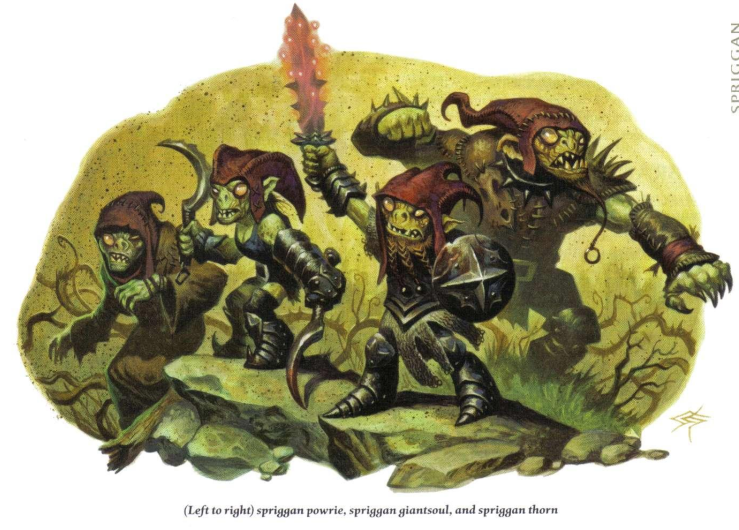
Copyright 2009 Wizards of the Coast. This article is part of a series! Click here to see the rest.
I can’t find spriggans in my 2nd edition and earlier books, but I know they’re in Pathfinder, so they were probably introduced in D&D 3.x. This entry is their 4e debut. It feels like there’s been some condensing here because this entry also uses several other names that I’m sure belonged to separate “small evil fey” enemies, like “redcap” and “powrie”.
The Lore
Back in the post on gnomes, we already saw that the gnome people used to be enslaved by the fomorians in the ancient past, but that they managed to escape. Here, we learn that not all of them managed to get away. Those unfortunates were eventually twisted into spriggans by fomorian magic. It’s unclear whether this happened as punishment for the escape attempt, or during some subsequent experiment.
The book doesn’t describe present-day spriggans as fomorian slaves, so maybe they were discarded by their former masters as failures. They live in underground settlements excavated under rugged terrain.
Fomorian magic warped spriggan hearts as much as it did their bodies. Soaking stuff in the blood of enemies seems to be a big deal to them. Their habit of doing that to their hats caused them to also be known as redcaps by other sapients. Spriggan communities delight in raiding, tormenting and extracting tribute from their weaker neighbors, behaving pretty much like bandit gangs.
The Numbers
Spriggans are Small Fey Humanoids with low-light vision and a ground speed of 6. Their signature ability is Redcap Zeal, a free-action encounter power that grants them temporary HP when they bloody or defeat an enemy.
Spriggan Giantsoul
Giantsouls tap into the fomorian magic in their blood, which gives them enhanced strength and the ability to stretch their arms to gain a giant’s reach. They’re Level 8 Brutes with 106 HP.
These spriggans fight unarmed, using slams as their basic attack. The stretch-arm thing comes into play in the Giantsoul Slam special attack (recharge 4+), which is Reach 2, does the same damage as the slam, and knocks prone on a hit. Both attacks deal bonus damage when the spriggan is bloodied.
Once per encounter, the giantsoul can use a Surprise Slam, an interrupt that triggers when an enemy within 2 squares of them attacks an ally. This allows it to use Giantsoul Slam against the triggering enemy, recharging the ability if necessary.
They’re good frontliners, with a limited ability to protect squishier allies when the PCs try to get around them.
Spriggan Powrie
All spriggans use iron-shod boots as part of their combat gear, but powries have a particular dedication to the fine art of stomping. They’re Level 7 Skirmishers with 79 HP.
The powrie fights with a sickle that does light physical damage and inflicts ongoing damage. It can also be used in a Hamstring special attack that has the same effects and also knocks prone and slows for a turn. This recharges when the powrie is first bloodied.
Against prone enemies it can use the amusing Punt The Fallen attack, which deals the same damage as the sickle and pushes 3 squares. The best thing about this attack is that it’s an at-will minor action!
If the powrie has combat advantage against a creature taking ongoing damage, attacking that creature with any of the above will also increase their ongoing damage by 5.
Finally, the Blood Slide passive trait prevents the powrie from provoking opportunity attacks when leaving a square adjacent to a creature who’s bloodied or taking ongoing damage.
So most of the time a powrie will be attacking enemies with the sickle and moving around the battlefield with the aid of Blood Slide in order to spread as much ongoing damage around as possible, and will then seek combat advantgae against a single target. Hamstring and Punt the Fallen is an hilarious combination, and the latter means powries pair really well with other enemies who can drop targets prone more often. Multiple powries in a fight mean you can begin an impromptu soccer match with a prone PC as the ball.
Spriggan Thorn
The spriggan thorn is armed with a short sword and a light shield, which are imbued with a curse of thorns. The sword itself is enveloped in them, and the spriggan can curse an enemy and cause thorns to spring from under their skin. It’s a Level 6 Soldier with 71 HP.
The Short Sword damages and inflicts ongoing damage (thorns!). It can be enhanced with the Drowsing Puncture power as a minor action. This makes the next attack daze the target for a turn and knock them prone, if it hits. It recharges when the thorn is first bloodied.
The curse is called Mark of Thorns, and it’s an encounter power that automatically hits a target in a Close Burst 5. A cursed target can’t make opportunity attacks against the thorn, and takes 4 damage at the end of any turn in which it didn’t attack the thorn. Any allies of the target that start the turn adjacent to them also take 4 damage.
Drowsing Puncture is a fine skill to use against PC defenders, and the Mark is quite versatile. When used against a defender, it allows the thorn to slip past the PC front-line unmolested. It also works to diver the attention of any PC who would normally gain more by attacking one of the spriggan’s more fragile allies. They pair really well with powries, who can end up increasing the ongoing damage caused by the swords.
Spriggan Witherer
Witherers are spriggan spellcasters who specialize in harmful weather control magic. They can probably cause serious trouble to agrarian communities with rituals, and they can also create more localized effects useful in combat. They have an obsession with soaking the earth in blood, so they pair well with enemies with a similar imagery. They’re Level 8 Artillery with 70 HP and the Leader keyword.
Their melee attack is a whithering touch vs. Reflex that deals necrotic damage. Their main single-target ranged attack is Sun Scorch (Ranged 10 vs. Reflex) dealing fire and radiant damage. They can use a spell named Flattening Wind either as a close blast 3 or as an area 3/range 10 attack vs. Fortitude. This deals physical damage, pushes 2 squares, and knocks prone. It recharges when they’re first bloodied.
After they’re bloodied, they can use Blood For the Earth at will. This is an area 2/range 10 attack that deals light physical damage, inflicts ongoing damage, and gives 5 temporary HP to any allies caught in the area.
This makes for an artillery threat that starts off fairly aggressive and switches to more of a support role as the fight proceeds.
Sample Encounters and Final Impressions
Spriggans are fairly good at fulfilling the “small evil fey” niche, and I love the ties to fomorian lore. There are some good synergies between the stat blocks presented here,
Spriggans can still be found working for fomorians, but some also work for evil eladrin or run their own rackets. They keep dangerous plants and animals around their settlements for protection.
The sample encounter is level 9: an evil eladrin twilight incanter with a pet shambling mound and a quartet of spriggan goons (2 giantsouls, 2 witherers).
subscribe via RSS